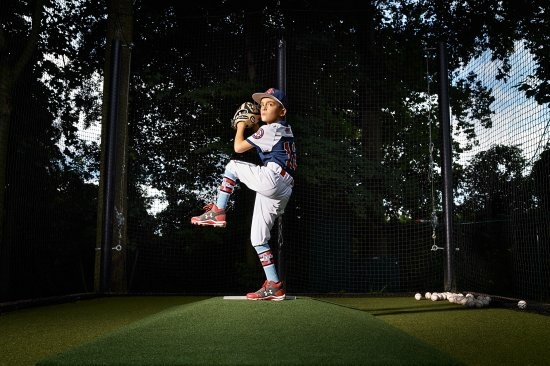Melissa Ward Jones took the water level sensor for download near the Teshekpuk Lake Observatory in Alaska, while her daughter, then two years old, sketched in a notebook. Image copyright Benjamin Jones
We are two scientists and early career moms who regularly do fieldwork in the Arctic, where travel can take days, and is often weather dependent and limited to a few months of the year. As with other fieldwork locations, there are often no shops or services available nearby, and cellular or Internet connections often rely on satellite communications, if available at all.
To thrive and survive in academia, researchers have to overcome many obstacles. Those with young children can face even greater hurdles, especially if they have a special field program1. One way of dealing with this is to challenge the myth that scientists are people who can devote all their time to research, with little or no family responsibilities to hold them back. Funding institutions spend millions of dollars training graduate students to do science, but this investment can evaporate if researchers leave academia or fieldwork-based research after becoming parents. Our experience with bringing families to work remotely shows that such research can be balanced with family life if there is the right support (See ‘Tips for doing remote fieldwork with children’).
Fieldwork is essential to many disciplines, providing data and shaping and advancing knowledge. But while practical support for parent-scientists is growing (many conference organizers, for example, now provide child care), policies around fieldwork have remained largely stagnant. This means that many early-career researchers may not be able to carry out fieldwork in remote areas while also caring for young children. That needs to be changed. Not everyone can take their children with them; for example, the presence of minors would be a safety issue on ships and at some Arctic research stations.
We asked academic collaborators, logistics companies, and funding agencies to consider increasing their support for parent-scientists who wish to do fieldwork in remote areas — with or without their children.
Support and solutions
Multiple layers of support — including funding and childcare, as well as assistance from institutions, colleagues, and families — must come together for parent-scientists to successfully undertake remote fieldwork. On the same subject : ‘N * Gen’ brings science to TVs in Africa. If one layer disappears, the fieldwork for parent-scientists may also be lost.
M.W.J., for example, has conducted remote geomorphological fieldwork since 2013, including trips to the islands of Ellesmere and Axel Heiberg in the Canadian High Arctic; to Svalbard, Norway; and throughout Alaska. During his graduate studies, he completed ten seasons and gained skills in summer and winter long-distance camping, advanced wilderness first aid, firearm use, and long-distance communication.
Tips for conducting remote fieldwork with children
• Make sure you have been trained in, and have gained experience, the geographic area you will be traveling to, and an evaluation of the risks of bringing your children. Make sure that you or someone on the team has first aid training, preferably specifically for wilderness emergency care. On the same subject : 21,020 children’s books awarded through SMIF’s Early Literacy Grant program – Austin Daily Herald. Pediatric training is also important because some treatment procedures are different for children.
• Always carry a communication device with you, either to communicate with other members of the field crew, or to seek assistance in a potential emergency. (For the former, you can use an off-grid device such as the goTenna, made by the New York City company of that name; for the second, a satellite SMS device, such as Garmin’s inReach in Olathe, Kansas, or a satellite phone, are options. )
• Think ahead about potential scenarios and how you can address them using what you will have. Consider minor issues, such as running out of baby wipes, as well as major issues — like what to do when you encounter wildlife.
• Gear up for all weather conditions, and wear bright colored field clothes to increase visibility.
• Give your child their own field notebooks and fieldwork — even pretend work. M.W.J’s daughter enjoys watching pin flags and stirring pools of water with a stick, and it keeps him busy while M.W.J. measurements were made.
• Give your child the space and freedom to adapt. Adjust your field’s expectations. Toddlers are slow and easily distracted. You may have days when nothing is done – take a deep breath and try again.
• Promote a diverse and inclusive atmosphere at field stations and camps — an atmosphere that encourages dialogue and interaction between researchers, especially those with children. This will expand participation for the next generation of field researchers.
These fieldwork skills made her feel comfortable taking her daughter to the Teshekpuk Lake Observatory (TLO) in Arctic Alaska, which is about 130 kilometers southeast of Utqiaġvik — the closest settlement and northernmost community in the United States.
It happened in 2019, when her daughter was less than two months old and exclusively breastfeeding. M.W.J.’s husband, who founded and directs TLO, is also a scientist at the University of Alaska Fairbanks (UAF) and an advocate for promoting diversity, equity, and inclusion in Arctic field research programs. The two share the duties of parenting at a remote research station, and ensuring that the presence of a small child is welcomed and accepted among a field crew of 5 to 11 researchers.
Their daughter joins them on two further trips to TLO, in 2020 and 2021, as the COVID-19 lockdown prevents family members from traveling to babysit. Now three years old, he also regularly takes fieldwork trips in the Fairbanks area.
M.B. had his son during his PhD studies at the Center for Permafrost (CENPERM) in Copenhagen. The head of the center often takes her two young daughters to Greenland to do fieldwork and encourages her and other staff members to follow her with their toddler.
Mette Bendixen’s son, then six years old, walks by the beach in Nuuk, Greenland.Credit: Mette Bendixen
Mette Bendixen’s son, then six years old, walks by the beach in Nuuk, Greenland.Credit: Mette Bendixen
Part of the work takes place at the Zackenberg Research Station in northeastern Greenland. Only people with scientific, educational, or cultural purposes were allowed to enter this remote area, so he couldn’t take his son with him. During periods of intense fieldwork, which often lasted several weeks, her husband cared for her alone, at their home in Montreal, Canada. However, he took his son, now eight years old, with him when he traveled to Greenland’s capital, Nuuk, to give talks, teach, and attend meetings. Similarly, when her son was four years old, her husband, also a scientist at McGill University, Montreal, had taken him to a research group retreat, with the support of his principal investigator.
Make policies more inclusive
Getting everyone out on the field has its challenges. M.W.J. has found that her child’s presence in a rental vehicle often violates the insurance policy of the company that manages the logistics of her research. As a result, he was forced to rearrange fieldwork trips, or even cancel them at the last minute. This continues to be an obstacle for M. See the article : 4000 beagles!.W.J. and other parent-scientists. He had to prepay for a rental vehicle that was allowed to travel on gravel roads—a huge financial expense—and then be reimbursed later. Her daughter is also not allowed to board charter flights provided by support and logistics companies, force her and her husband to make other rental arrangements at the last minute, or pay out of their pocket for distant family members to cover childcare.
As a possible solution, fieldwork managers could include waivers to allow children to travel by vehicle, modify payment schemes to remove reimbursement barriers or provide additional funding opportunities to support scientist-parents conducting remote fieldwork.
Let travelling parents claim for childcare
Funding policies regarding childcare costs are highly unequal globally. We argue that parents in the field should be able to claim home care costs — or that policies should cover costs, such as airfare and caregiver salaries, associated with bringing caregivers and children to the field.
A good support model already exists. Denmark’s Carlsberg Foundation, which previously funded the M.B., provides additional financial support to researchers with parenting responsibilities through Internationalization Fellowships. The National Geographic Society in Washington DC allows dependent care as a line item on all grant applications and disbursements, but requires written justification. The US National Science Foundation is offering additional funding through its Career-Life Balance initiative to support additional personnel, such as research assistants or technicians, who can temporarily replace research team members, graduate students or postdoctoral students taking family leave.
Normalize conducting fieldwork with children
Parent scientists who are required to do fieldwork, or conduct research in remote areas, should seek the support they need. This requires a cultural shift in academia among peers, to raise awareness of how common parenthood is. As a first step towards normalizing the idea of doing fieldwork with children, researchers should include photos in lectures and scientific presentations showing children in place, and should use children to give a sense of scale in field photos. It can help inspire students, scientist-parents and parents-to-be.
The COVID-19 pandemic has shown us the difficulties that can arise for parents when parenting networks break down. Scientist-parents always have to overcome challenges to do fieldwork. We expect resilience that has emerged in response to the pandemic — such as greater tolerance for background noise and distraction by children, pets, and partners in virtual gatherings — will extend to increased support for families of scientists wishing to do work in remote areas. around the globe.



